Viscosity And Surface Tension Very Short Answer Type Questions
Question 1. What is the nature of a fluid flow when the speed of the fluid exceeds critical velocity?
Answer: Turbulent
Question 2. Write down the dimension of the coefficient of viscosity.
Answer: ML-1T-1
Question 3. What is the dimension of the Reynolds number?
Answer: M0L0T0
Question 4. State the nature of the dependence of the terminal velocity of a body in a viscous medium with the coefficient of viscosity of the medium.
Answer: Inversely proportional
Question 5. Can two streamlines intersect each other?
Answer: No
Read And Learn More WBCHSE Class 11 Physics Very Short Question And Answers
Question 6. The viscous force is proportional to the velocity gradient.
Answer: Directly
Question 7. State whether the viscosity of a gas increases or decreases due to an increase in temperature.
Answer: Increases
Question 8. State whether the viscosity of a liquid increases or decreases due to an increase in temperature.
Answer: Decreases
Question 9. How does the viscosity of a liquid change with an increase in pressure?
Answer: Increases
Question 10. How does the viscosity of water change with an increase in pressure?
Answer: Decreases

WBBSE Class 11 Viscosity and Surface Tension Very Short Answer Questions
Question 11. How does the velocity of flow change with the cross-sectional area of a tube of flow?
Answer: Increases with a decrease in cross-sectional area
Question 12. If a liquid flows through a tube, then what is the velocity of the layer of liquid in contact with the tube?
Answer: Zero
Question 13. 1 Pa • s =? poise.
Answer: 10
Question 14. Liquid : viscocity:: solid : _______
Answer: Friction
Question 15. Which conservation law is expressed by the equation of continuity?
Answer: Law of conservation of mass
Question 16. On which conservation principle is Bernoulli’s theorem established?
Answer: Principle of conservation of energy
Question 17. To what kind of liquid is Bernoulli’s theorem applicable?
Answer: Ideal liquid
Question 18. What is the name of the force of attraction between the molecules of two different substances?
Answer: Adhesive force
Question 19. What do you call the tendency of a liquid to contract its surface area?
Answer: Surface tension
Question 20. Write down the dimension of surface tension.
Answer: MT-2
| Class 11 Physics | Class 12 Maths | Class 11 Chemistry |
| NEET Foundation | Class 12 Physics | NEET Physics |
Question 21. What is the dimension of surface energy?
Answer: MT-2
Question 22. State whether the surface tension of a liquid increases or decreases due to an increase in temperature.
Answer: Decreases
Question 23. Does the surface tension of a liquid depend on the nature of the medium just above the free surface of tire liquid?
Answer: Yes
Question 24. If the temperature remains fixed, then the surface energy per unit area of a liquid surface is numerically equal to the surface tension of the liquid. Is the statement true or false?
Answer: True
Question 25. What is the SI unit of surface tension?
Answer: N · m-1
Question 26. If a liquid has dissolved organic matter in it, then how does the surface tension of the liquid change?
Answer: Decreases
Question 27. State whether mercury rises or falls inside a glass capillary tube when the tube is dipped into mercury.
Answer: Falls
Question 28. What will be the shape of the mercury meniscus inside a capillary tube when it is dipped into mercury?
Answer: Convex
Question 29. The angle of contact for a solid and a liquid is more than 90°. If the solid is dipped into the liquid, then will the liquid stick to the surface of the solid?
Answer: No
Key Concepts in Viscosity and Surface Tension Short Answers
Question 30. Name the material of a container for which the upper surface of water remains horizontal.
Answer: Silver
Question 31. State whether all liquids will rise in a capillary tube.
Answer: No
Question 32. Name the property due to which a blotting paper can absorb ink.?
Answer: Capillarity
Question 33. When a capillary tube is dipped into water, water rises inside the tube. If the tube is made thinner then how will the rise in the water level change?
Answer: Greater
Question 34. Give the nature of angle of contact for which the liquid wets the solid surface?
Answer: Acute
Viscosity And Surface Tension Match Column 1 With Column 2
Question 1. Two soap bubbles combine to form a single big bubble.
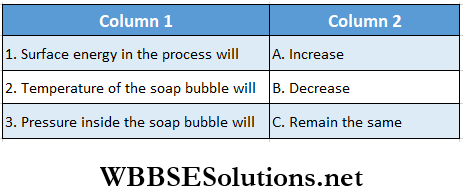
Answer: 1. B, 2. A, 3. B
Question 2.
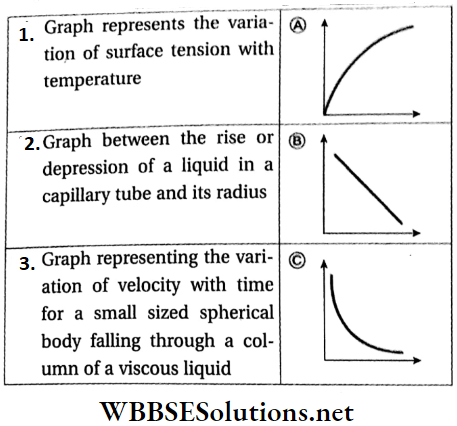
Answer: 1. B, 2. C, 3. A
Question 3. Match the two following columns
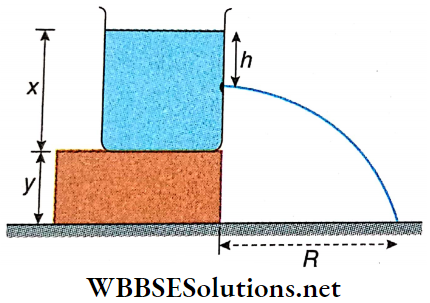
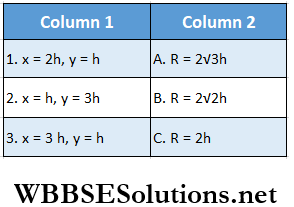
Answer: 1. B, 2. A, 3. A
Question 4.
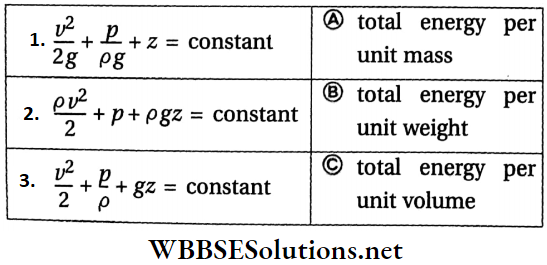
Answer: 1. B, 2. C, 3. A
Question 5.
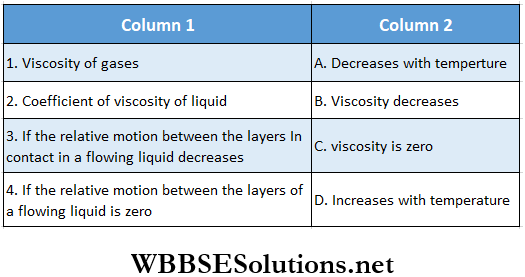
Answer: 1. D, 2. A, 3. B, 4. C
Comparative Analysis of Viscosity and Surface Tension
Viscosity And Surface Tension Comprehension Type Questions And Answers
Read the following passages carefully and answer the questions at the end of them.
Question 1. When liquid medicine of density p is to be put in the eye, it is done with the help of a dropper. As the bulb on the top of the dropper is pressed, a drop forms at the opening of the dropper. We wish to estimate the size of the drop. We first assume that the drop formed at the opening is spherical because that requires the minimum increase in its surface energy. To determine the size, we calculate the net vertical force due to the sur¬face tension T when the radius of the drop is R. When the force becomes smaller than the weight of the drop, the drop gets detached from the dropper.
1. If the radius of the opening of the dropper is r, the vertical force due to the surface tension of the drop of radius R (assuming r << R) is
- \(2 \pi r T\)
- \(2 \pi R T\)
- \(\frac{2 \pi r^2 T}{R}\)
- \(\frac{2 \pi R^2 T}{R}\)
Answer: 3. \(2 \pi r T\)
2. If r = 5 x 10-4 m, ρ = 103 kg · m-3, g = 10 m · s-2, T = 0.11 N · m-1 the radius of the drop when it detaches from the dropper is approximately
- 1.4 x 10-3 m
- 3.3 x 10-3 m
- 2.0 x 10-3 m
- 4.1 x 10-3 m
Answer: 1. 1.4 x 10-3 m
3. After the drop detaches, its surface energy is
- 1.4 x 10-6 J
- 2.7 x 10-6 J
- 5.4 x 10-6 J
- 8.1 x 10-6 J
Answer: 2. 5.4 x 10-6 J
Question 2. The figure shows a glass capillary tube of radius r dipped into water. The atmospheric pressure is p0 and the capillary rise of water is h. Surface tension for water-glass is S.
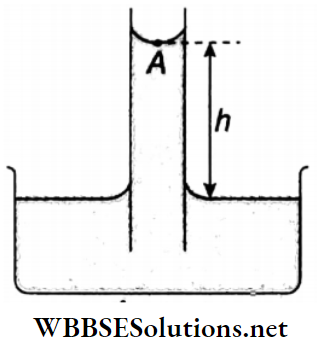
1. The pressure inside water at the point A (the lowest point of the meniscus) is
- p0
- \(p_0+\frac{2 S}{r}\)
- \(p_0-\frac{2 S}{r}\)
- \(p_0-\frac{4 S}{r}\)
Answer: 3. \(p_0-\frac{2 S}{r}\)
2. Initially h = 10 cm. If the capillary tube is now inclined at 45°, the length of water rise in the tube will be
- 10 cm
- 10√2 cm
- \(\frac{10}{\sqrt{2}}\) cm
- None of these
Answer: 2. 10 72 cm
Real-Life Examples of Viscosity Effects – Brief descriptions of real
Question 3. A container with a large uniform cross-sectional area A resting on a horizontal surface, holds two immiscible, non-viscous, and incompressible liquids of densities d and 2d each of height H/2 as shown in Fig. The lower density liquid is open to the atmosphere having pressure p0. A tiny hole of area S (S << A) is punched on the vertical side of the container at a height h (h < H/2). As a result of this, liquid starts flowing out of the hole, with a range x on the horizontal surface.
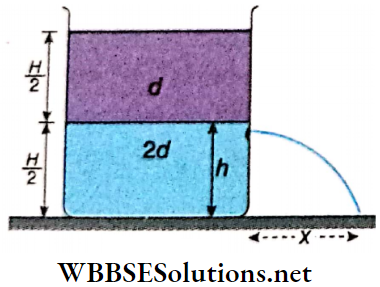
1. The initial speed of efflux of the liquid at the hole is
- \(v=\sqrt{\frac{g}{2}(3 H+4 h)}\)
- \(v=\sqrt{\frac{g}{2}(4 H-3 h)}\)
- \(v=\sqrt{\frac{g}{2}(3 H-4 h)}\)
- \(v=\sqrt{\frac{g}{2}(4 H+3 h)}\)
Answer: 3. \(v=\sqrt{\frac{g}{2}(3 H-4 h)}\)
2. The horizontal distance traveled by the liquid, initially is
- \(\sqrt{(3 H+4 h) h}\)
- \(\sqrt{(3 h+4 H) h}\)
- \(\sqrt{(3 H-4 h) H}\)
- \(\sqrt{(3 H-4 h) h}\)
Answer: 4. \(\sqrt{(3 H-4 h) h}\)
3. The maximum horizontal distance traveled by the liquid is
- \(x_{\max }=\frac{H}{4}\)
- \(x_{\max }=\frac{2 H}{4}\)
- \(x_{\max }=\frac{3 H}{4}\)
- \(x_{\max }=\frac{5 H}{4}\)
Answer: 3. \(x_{\max }=\frac{3 H}{4}\)
Question 4. Water flows through a horizontal tube of variable cross-section. The areas of cross-section at A and B are 4 mm2 and 2 mm2 respectively. Given that 10-6 m3 of water enters per second through A.
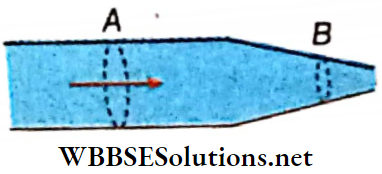
1. The speed of the water at A is
- 1.00 m · s-1
- 0.75 m · s-1
- 0.25 m · s-1
- 0.50m · s-1
Answer: 3. 0.25 m · s·
2. The speed of the water at B is
- 1.00 m · s-1
- 0.30m · s-1
- 0.70 m · s-1
- 0.50 m · s-1
Answer: 4. 0.50 m · s-1
3. The pressure difference pA – pB is
- 85 N · m-2
- 94 N · m-2
- 100 N · m-2
- 105 N · m-2
Answer: 2. 94 N · m-2
Question 5. Let n number of little droplets of water of surface tension S dyn · cm-1, all of the same radius r cm, combine to form a single drop of radius R cm. J is Joule’s mechanical equivalent of heat. While using the CGS system of units answer the following questions.
1. The energy released is
- S x 4π nr²
- S X 4π R²
- S x 4πr²n [1 – n1/3]
- S x 4πR² [n2/3 – 1]
Answer: 3. S x 4πr²n [1 – n1/3]
2. If the whole energy released is taken by the water drop formed, then rise in temperature in °C is
- \(\frac{S}{J}\left[\frac{1}{r}-\frac{1}{R}\right]\)
- \(\frac{4 S}{J}\left[\frac{n}{r}-\frac{1}{R}\right]\)
- \(\frac{3 S}{J}\left[\frac{1}{r}-\frac{1}{R}\right]\)
- \(\frac{S}{J}\left[\frac{n}{r}-\frac{1}{R}\right]\)
Answer: 3. \(\frac{3 S}{J}\left[\frac{1}{r}-\frac{1}{R}\right]\)
3. What is the change in excess of pressure inside the big drop formed and a small drop if the change in temperature is ignored?
- \(2 S\left[\frac{1}{r}-\frac{1}{R}\right]\)
- \(S\left[\frac{1}{r}-\frac{1}{R}\right]\)
- \(S\left[\frac{n}{r}-\frac{1}{R}\right]\)
- \(2 S\left[\frac{n}{r}-\frac{1}{R}\right]\)
Answer: 1. \(2 S\left[\frac{1}{r}-\frac{1}{R}\right]\)
Question 6. A cylindrical tank is open at the top and has a cross-sectional area a1. Water is filled in it up to a height of h. There is a hole of cross-sectional area a2 at its bottom. Given a1 = 3a2
1. The initial velocity with which the water falls in the tank is
- \(\sqrt{2 g h}\)
- \(\sqrt{g h}\)
- \(\sqrt{\frac{g h}{2}}\)
- \(\frac{1}{2} \sqrt{g h}\)
Answer: 4. \(\frac{1}{2} \sqrt{g h}\)
2. The initial velocity with which the water emerges from the hole is
- \(\frac{1}{2} \sqrt{g h}\)
- \(\sqrt{2 g h}\)
- \(\frac{3}{2} \sqrt{g h}\)
- 2 \(\sqrt{2 g h}\)
Answer: 3. \(\frac{3}{2} \sqrt{g h}\)
3. The time taken to empty the tank is
- \(\sqrt{\frac{2 h}{g}}\)
- \(4 \sqrt{\frac{h}{g}}\)
- \(6 \sqrt{\frac{2 h}{g}}\)
- \(8 \sqrt{\frac{2 h}{g}}\)
Answer: 2. \(4 \sqrt{\frac{h}{g}}\)
Viscosity And Surface Tension Integer Type Questions And Answers
In this type, the answer to each of the questions is a single-digit integer ranging from 0 to 9.
Question 1. Two soap bubbles A and B are kept in a closed chamber where the air is maintained at a pressure of 8 N · m-2. The radii of bubbles A and B are 2 cm and 4 cm respectively. The surface tension of the soap water used to make bubbles is 0.04 N · m-1. Find the ratio nB/nA where nA and nB are the number of moles of air in bubbles A and B respectively. (Neglect the effect of gravity).
Answer: 6
Question 2. A vessel whose bottom has a round hole with a diameter of 1 mm is filled with water. Only surface tension acts at the hole. The surface tension of water is 75 x 10-3 N · m-1 and g = 10 m · s-2. What is the maximum height (in cm) to which water can be filled in the vessel without leakage?
Answer: 3
Question 3. A layer of glycerine of thickness 1 mm is present between a large surface area and a surface area of 0.1 m2. With what force (in N) the small surface is to be pulled, so that it can move with a velocity of 1 m · s-1? (Given the coefficient of viscosity = 0.07 kg • m-1· s-1)
Answer: 7
Question 4. A glass rod of diameter d1 = 1.5 mm is inserted sym-metrically into a glass capillary with inside diameter d2 = 2.0 mm. Then the whole arrangement is vertically oriented and brought in contact with the surface of water. To what height (in cm) will the liquid rise in the capillary? Surface tension of water = 73x 10-3 N · m-1
Answer: 6
Question 5. A metal ball of radius 2 mm and density 10.5 g · cm-3 is dropped in glycerine of coefficient of viscosity 9.8 dyn · cm-2 · s and density 1.5 g · cm-3. Find the terminal velocity (in cm · s-1) of the ball.
Answer: 8
